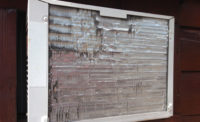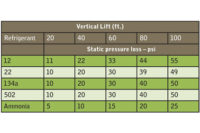SIDE-AIR-DISCHARGE CONDENSING UNITS
Air-cooled condensers all discharge hot air loaded with the heat absorbed from within the structure. Early condensers discharged the air out the side and were called side discharge. The advantage of this equipment is that the fan and motor are under the top panel. However, any noise generated inside the cabinet is discharged into the leaving airstream and may be clearly heard in a neighbor’s yard. NOTE: The heat from the condenser coil can be hot enough to kill plants that it blows on. The condensers are still being used.TOP-AIR-DISCHARGE CONDENSERS
The modern trend in residential equipment is for the condenser to be a top-discharge type. In this type of unit, the hot air and noise are discharged from the top of the unit into the air. This is advantageous as far as air and noise are concerned. But the fan and motor are on top of the equipment. Rain, snow, and leaves can fall directly into the unit. So the fan motor should be protected with a rain shield. The fan motor bearings are in a vertical position, which means there is more thrust on the end of the bearing, so the bearing needs a thrust surface for this type of application.CONDENSER COIL DESIGN
Some coil surfaces are positioned vertically, and grass and dirt can easily get into the bottom of the coil. The coils must be clean for the condenser to operate efficiently.Some equipment uses the bottom few rows for a subcooling circuit to lower the condensed refrigerant temperature below the condensing temperature. It is common for the liquid line to be 10 to 15°F cooler than the condensing temperature. Each degree of subcooling will add approximately 1 percent to the efficiency of the system. If the subcooling circuit is dirty, it could affect the capacity by 10 to 15 percent.
This could mean the difference in a piece of equipment being able to cool or not being able to cool a structure if the equipment were sized too close to the design cooling load.
Some manufacturers use horizontal or slant-type condensers to position the coil off the ground. These condensers are less likely to pick up leaves and grass at the ground level.
HIGH-EFFICIENCY CONDENSERS
Modern times and the federal government have demanded that air conditioning equipment become more efficient. Probably the best way to improve efficiency is to lower the head pressure so that the compressor is not working as hard because it now has a lower compression ratio.More surface area in the condenser reduces the compressor head pressure even in the hottest weather. This means lower compressor current and less power consumed for the same amount of air conditioning.
Some manufacturers with oversized condenser use two-speed condenser fans - one speed for mild weather, one for hot. Without two-speed fans, the condenser would be too efficient in mild weather, causing the head pressure to be too low, starving the expansion device and resulting in less capacity.
CABINET DESIGN
The condenser cabinet is usually located outside so it needs weatherproofing. Most cabinets are galvanized and painted to give them more years of life without rusting. Some cabinets are made of aluminum, which is lighter but may not last as long in a salty environment, such as coastal areas.Most small equipment is assembled with self-tapping sheet metal screws. These screws are held by a drill screw holder during manufacturing and are threaded into the cabinet when turned with an electric drill. These screws should be made of weather resistant material that will last for years out in the weather.
The weather may be salt air in the coastal areas. In these locations, stainless steel is a good choice of metal for sheet metal screws.
When equipment that is assembled with drill screws is installed in the field, all of the screws should be fastened back into the cabinet tightly, or the unit may rattle. After being threaded many times, the screw holes may become oversized. If so, use the next ½-size screw to tighten the cabinet panels.
Information on theRefrigeration & Air Conditioning Technologytextbook referenced in this article can be obtained by calling 800-648-7450.
Clarification:
John Tomczyk's column in the June 6 edition ofThe NEWSreferenced a retrofit refrigerant being used in the Ferris State University HVACR laboratories. It should be noted that the selection was based on the specific equipment to be retrofitted and not on testing of other refrigerant options, and does not represent an endorsement by Ferris State University for any particular retrofit refrigerant.Publication date:07/04/2011










